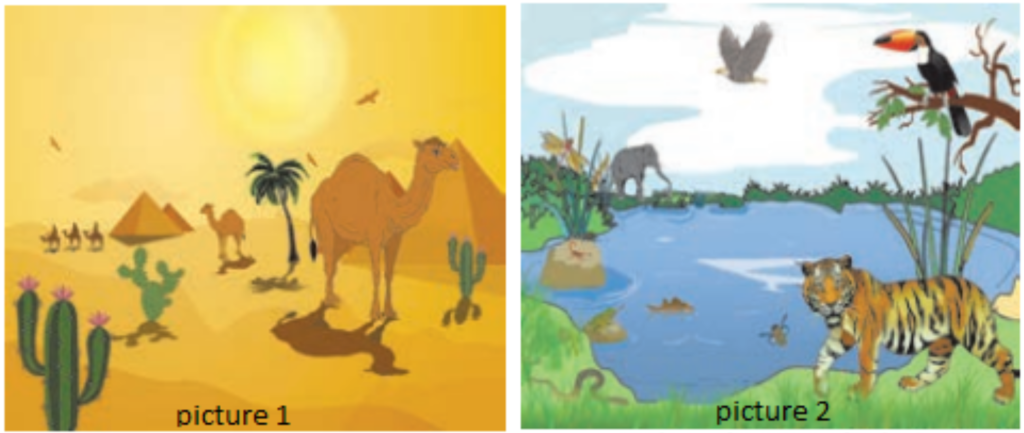
1. Complete the following by using the correct option:
a. Air, water, minerals, soil are ………….. factors of an ecosystem. (physical, organic, inorganic)
Answer:
Air, water, minerals, soil are physical factors of an ecosystem.
b. River, ponds, ocean are …………. ecosystems, (land, aquatic, synthetic)
Answer:
River, ponds, ocean are aquatic ecosystems.
c. Man is ………….. in an ecosystem. (producer, consumer, decomposer)
Answer:
Man is consumer in an ecosystem.
2. Match the following:
| Producer | Ecosystem |
| 1. Cactus | a. Forest |
| 2. Aquatic plants | b. Creek |
| 3. Mangroves | c. Aquatic |
| 4. Pine | d. Desert |
Answer:
| Producer | Ecosystem |
| 1. Cactus | d. Desert |
| 2. Aquatic plants | c. Aquatic |
| 3. Mangroves | b. Creek |
| 4. Pine | a. Forest |
3. Give my information:
a. Ecosystem.
Answer:
Ecosystem is the structure formed by the interrelationships between the living organisms and non-living components in their surrounding habitats. Living organisms are also called biotic factors while the non-living components are called abiotic factors. The abiotic and biotic factors have a reciprocal relationship with each other. The ecosystem has plants as producers, animals as consumers and microbes as decomposers.
The decomposers return the substances back to the nature by process of decomposition in which the organic complex molecules are reduced to their inorganic constituents. Thus the dead remains of plants and animals are once again recycled back to the nature in any healthy ecosystem.
b. Biome.
Answer:
Biomes are a larger collection of small ecosystems which are similar in their structure. In a particular biome there are same climatic, abiotic factors and similar living organisms. Biomes are of two main types, land biomes and aquatic biomes. The land biomes exist only on land. Land biomes are of following subtypes based on the abiotic factors. E.g. Grasslands, evergreen forests, deserts, Tundra ecosystem, ecosystems in Taiga, tropical rainforests, etc. Aquatic biomes include freshwater ecosystem, marine ecosystem and brackish water ecosystem found in the creeks.
c. Food web.
Answer:
The complex feeding relationships form a food web. In nature in any ecosystem, the food chains are not straight and linear. But these are quite complex. A prey is consumed by a predator but this predator can itself be a prey to some other predator. E.g. Frog is a predator for variety of insects but frog is preyed upon by snake and the snake can be eaten by a bird. The same bird can also feed on insects or frog. The interrelationships between different biotic components of any ecosystem thus form the complicated food web.

4. Give scientific reasons:
a. Plants in an ecosystem are called producers.
Answer:
are cut down causing deforestation. The wild animals lose their habitat. Many of them become extinct. There is great loss of flora and fauna due to construction of large dams. There is undue pressure on the land surface caused due to stored water column. This may cause earthquakes. The human settlements are removed as their houses and farms are immersed under water. In all the above ways large dams destroy the ecosystems.
b. Large dams destroy ecosystems.
Answer:
When a large dam is constructed, the original landscape is changed. The trees are cut down causing deforestation. The wild animals lose their habitat. Many of them become extinct. There is great loss of flora and fauna due to construction of large dams. There is undue pressure on the land surface caused due to stored water column. This may cause earthquakes. The human settlements are removed as their houses and farms are immersed under water. In all the above ways large dams destroy the ecosystems.
c. Rhinos were restored in Dudhwa forest.
Answer:
Long ago in last century, Dudhwa forest was the natural habitat of the one-horned Rhino. However, due to hunting and poaching, the Rhino became almost extinct. In order to restore it back the breeding in captivity was attempted and the young ones were released in the natural habitat. Saving the precious wildlife is important and hence these efforts were done.
5. Answer the following:
a. What are the effects of increased population (of human beings) on ecosystems?
Answer:
- Human population growth rate is very big as compared to other animals.
- Moreover, they are apex consumers in an ecosystem. Just like any other organisms, ecosystems provide all the basic needs to humans, too.
- However, man demands much more due to excessive population. The natural resources are utilized on the large scale only by man.
- Changing lifestyles, consumerism, degradation of nature and pollution are certain aspects which are created only by human beings.
- All these cause increased stress on the ecosystems. Large human population also produces large-scale solid wastes.
b. How is urbanization responsible for destruction of ecosystems?
Answer:
When people do not get sufficient food and other amenities, they migrate to the cities. The cities provide employment for many people due to industries, factories and other facilities. Every day many people migrate to cities. This causes urbanization. Due to increased population in cities, there is more need for housing. This results in loss of agricultural lands, marshlands, wetlands, forests and grasslands, etc.
The natural ecosystems are lost in an attempt to have developmental work. Human interference causes changes in the ecosystems. When land usage is changed many naturally occurring species of plants and animals are exterminated. Animal- human conflicts are very common in newly established urban areas which are near the natural forests.
c. What are the reasons for war?
Answer:
There are difference of opinions and competition over land, water, mineral resources, etc. among neighbouring countries. Moreover, there can be economic and political causes which lead to war among different countries. Many times the l religions and ethnicity are also caused for dispute. Due to international conflicts, the peace is disturbed and it results in war.
d. Explain the interactions among the factors of an ecosystem.
Answer:
- The abiotic factors such as air, water, soil, sunlight, temperature, humidity, etc. affect the biotic factors, i.e. the surviving plants, animals and microbes in the ecosystem.
- The type of abiotic factors in an ecosystem determine the survival of biotic factors. The population of these biotic factors is also dependent on the quality of abiotic factors.
- The proportion of abiotic factors in an ecosystem fluctuates as biotic factors use up or release particular abiotic factors.
- Every biotic factor also interacts with its necessary abiotic factors as well as other biotic factors around it.
e. Differentiate between evergreen forests and grasslands.
Answer:
| Evergreen forests | Grasslands |
| 1. About seven percent of the Earth’s surface is occupied by evergreen forests. | 1. About 30 percent of the Earth’s surface is covered by grasslands. |
| 2. More than half of the earth’s terrestrial plants and animals are seen in evergreen forests. | 2. Grazing animals are seen in grasslands. |
| 3. Tropical evergreen forests are dense, multi-layered. | 3. Grasslands consist of tall grass. There are wild grasses and there may be some trees. |
| 4. These forests are found in the areas receiving more than 200 cm annual rainfall i.e. very heavy rainfall. | 4. There is an average of 20 – 35 inches of rainfall a year in grasslands. |
| 5. Tropical regions show evergreen forests. | 5. Several parts of the world have grasslands. |
6. Describe the following pictures:

Answer:
The picture no. 1 is showing desert ecosystem, while the picture no. 2 is showing a forest ecosystem where a wetland (a lake) is also shown. In desert ecosystem, the producers are green cactus and a palm tree. Since in desert there are scanty rains, the vegetation is very less. The soil is sandy soil. The consumers of the desert are also limited.
In the above picture camel is shown which is a primary consumer in the desert ecosystem. Camel is very well adapted for desert life. There is also the scarcity of water in desert and hence cactus shows xerophytic (suitable to survive in desert) adaptations.
In second picture, the forest ecosystem is shown because we can see elephant and tiger in the picture. Also, giant hornbill is sitting on the tree. This forest must be tropical evergreen forest. The rainfall is heavy in such areas and hence different types of wetlands can be seen in forests. Wetlands support variety of life. A separate aquatic ecosystem does exist here which is closely interconnected with the terrestrial ecosystems through food chains and food web.
The birds utilize the fish as their prey. The wild animals come to wetlands to quench their thirst. In this picture the plants, grass, etc. are producers, small fishes in the lake are primary consumers. They will be eaten by larger fishes which are secondary consumer in the aquatic ecosystem. The elephant is herbivorous animal and hence it is primary consumer. Snake is the secondary consumer while the birds of prey (eagle that is flying) and tiger are tertiary consumers.


